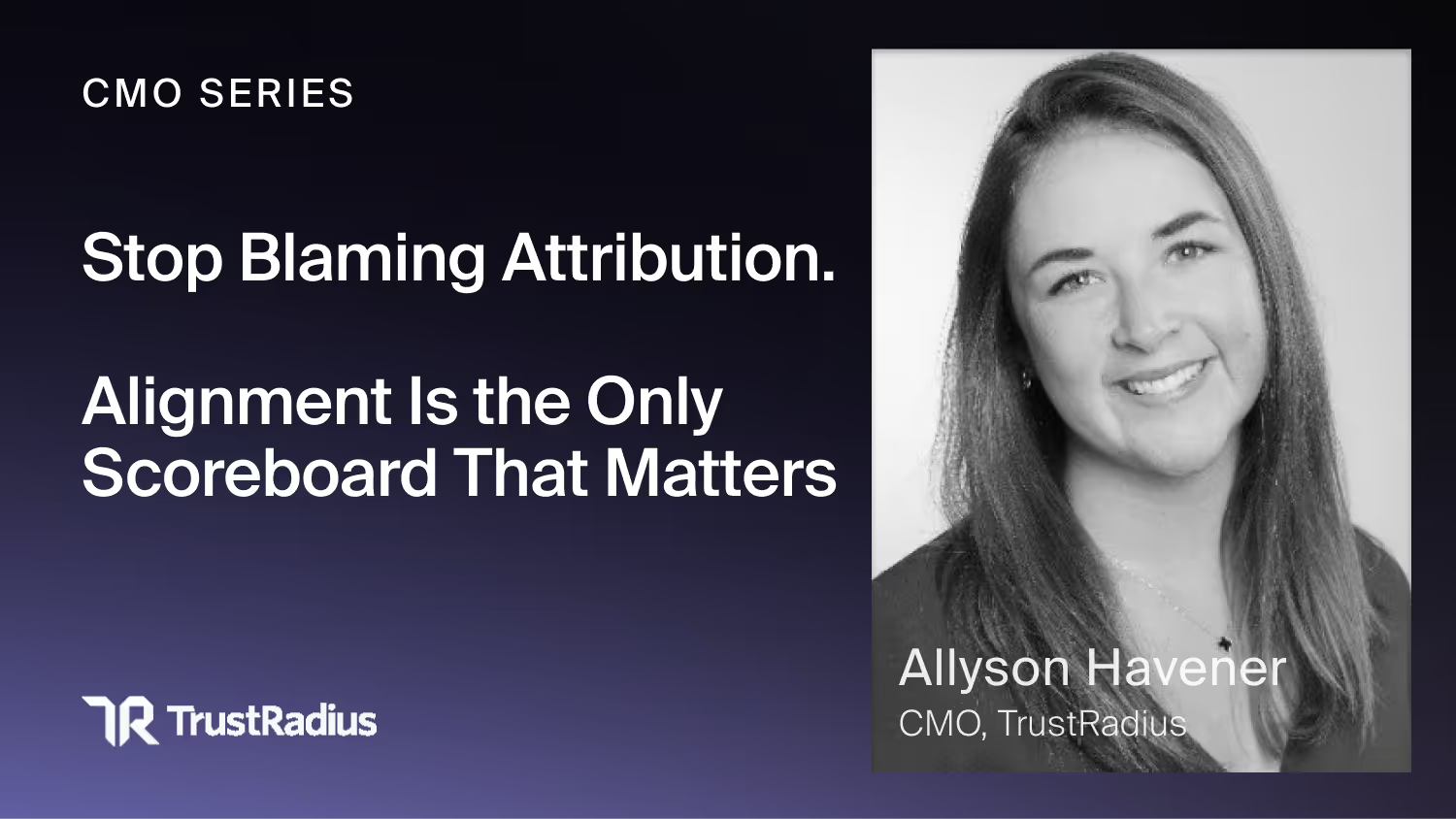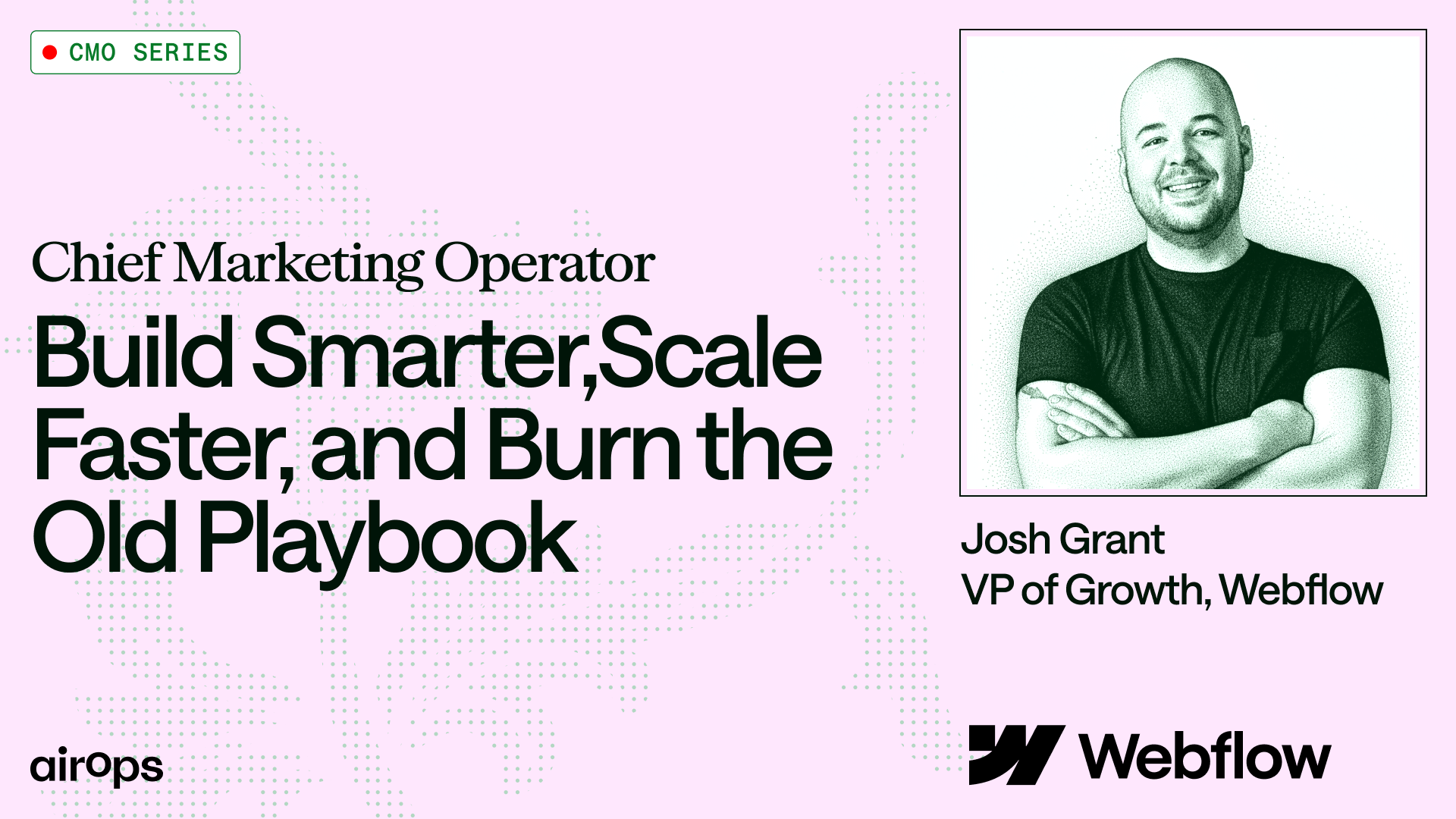Stop Blaming Attribution. Alignment is the Only Scoreboard That Matters

- Revenue Alignment > Attribution
Sales and marketing need to share the same scoreboard (revenue + pipeline), not argue over who gets credit. - Buyers Expect Transparency
Today’s buyers want to see pricing, real customer proof, and product experience before they ever talk to sales. - Original Content Still Wins
Authentic stories and real customer voices stand out more than ever as your own unique POV. Think of content consumption as a leading metric. - Ops & Feedback Loops Matter
Teams that meet regularly, share KPIs, and close the loop between sales and marketing see higher ACV and win rates.
Buyers bounce between AI summaries, peer reviews, and search long before they talk to anyone. By the time they’re in your sales cycle, attribution software can’t tell you deterministically what actually influenced them.
Everything used to feel linear or at least we wanted it to be. Now, the old GTM doesn’t work at all. The traditional attribution models don't tell the full story or which optimization decisions to make.
For us, alignment between sales, customer success and marketing became our core principle. We make decisions based on the way buyers buy and our ideal customer journey. Because attribution is noisy, alignment keeps decisions crisp.
The future of growth isn’t about who sourced the lead or who gets credit. It’s about how we influenced it together across touchpoints.
Buyer Behavior Has Changed
The buyer you think you’re marketing to doesn’t exist anymore. According to a recent TrustRadius report:
- 100% of buyers want to self-serve product info.
- 63% shortlist 2-3 products
- 78% pick brands they already know
Their mind is mostly made up by the time they ever interact with sales, if they ever do.
Real competition happens long before the first call. Brand visibility is key for survival. Show up early with a clear brand message and credible social proof, or you won’t make the shortlist at all.

Compare The Buyer’s Journey vs. Your Marketing Map
Buyers don’t move in neat stages. They loop through peer conversations, communities, AI overviews, peer referrals, and review sites like TrustRadius. Take a look at your customer journey map and check it for reality. You’ll see the disconnect. Marketing has to enable the buyer by giving them the information they want in the forums they are in.
And here’s the kicker: only 5% of your market is in-market at any given time. The other 95%? They’re deciding who they’ll trust and other opinions over time.
How do you approach this? Gain mindshare, build a trusted brand, let your best customers attract your next ones, and keep the motion compounding into a flywheel.
We codified this shift in our KPI framework. Marketing tracks website traffic, content consumption, and pipeline generated. Sales/CS tracks accounts touched, POC engagement, quota attainment, and renewal rate.
The overlap—pipeline, ACV, LTV, ARR, NRR—is the shared scoreboard.
If Sales and Marketing don’t meet the buyer together, you don’t meet them at all.

Alignment Is the New Attribution
Winning teams don’t argue over attribution. Instead, they share it. We stopped making decisions based on who sourced the deal. Instead, marketing built joint OKRs with the CRO and field team.
First, our marketing campaigns run adjacent to active sales plays. First-party signals are pushed into prospecting tools to make sales outreach more efficient. Those signals are becoming smarter, contextual, and tied to content consumption.
Pipeline generation, deal acceleration, content influence, and buyer trust are the metrics that matter. That also means tracking win rate and expansion/retention directly in the shared scoreboard.
Next, the CRO and I take our results to the board. They want one GTM story with a unified talk track, so we make it a joint effort. Our revenue story, the data, and the takeaways are aligned before we ever walk into the room.
Regular OKR planning locks in this process. In our OKR chart, marketing and sales are side-by-side under the same business objectives. This avoids the week-to-week ping-pong that kills momentum.
Then, our operating cadence makes it real: weekly CRO–CMO syncs, a shared message-testing log, and an objection tracker that feeds straight into content and enablement.
Those rituals keep alignment from becoming theater.

You Don’t Need More Leads. You Need a Signal Layer.
Shared scoreboards, joint OKRs, and operating rituals are a good structure, but that’s not enough. You also need the right signals to power it.
That’s where the next part comes in: build a shared signal layer that turns buyer behavior into actionable intelligence.
MQLs aren’t dead, but they’re no longer at the center of the game. At TrustRadius, we still use MQLs to measure (not attribute) success of a campaign. However, when it comes to sales they are using , a richer signal layer of first- and third-party data to prioritize accounts, know who to reach out and to create relevant messaging.
That signal layer includes:
- Content consumption across education, pricing, and comparison assets.
- Review engagement and quality, with recency and credibility mattering more than raw volume.
- Pricing and comparison intent captured on pages that signal late-stage readiness.
- AI-search visibility, measured by how often your brand surfaces in answers and summaries.
- Objections surfaced in sales calls that marketing can preempt with content and messaging.
We prioritize and push signals for prospecting and deal acceleration—so sales isn’t chasing cold leads, but are acting on warm intent. SDRs and AEs get richer context for outreach such as what content was consumed, which comparisons were viewed, and which reviews were read.
Signals give the what. Sales gives the why. Without that loop, teams operate in a vacuum. And vacuums don’t surface or close deals.
Influence What Can’t Be Tracked
The most powerful influence happens where attribution can’t see: visibility in AI answers, peer referrals, and third-party proof.
Credibility is the lever.
That’s why we bet on content consumption as our anchor metric. It includes email open rates, CTR, time on site, pages visited and engagements per campaign. The more your audience takes in over time, the more you build a trusted brand and earn mindshare.
We track engagement across the full funnel. Content consumption is a leading indicator of revenue impact and not vanity metrics.
As an example of credible content, we doubled down on promoting the quality of our reviews, even publishing our review criteria and moderation process.
And we built a 65-page brand guide to help us lock tone and POV across every channel. Then we pull customer transcripts and fold their language straight into our audits.
AI can summarize facts, not conviction. Your POV, customer voice and credibility creates your moat.

Final Word
Attribution will never be perfect again. The buyer journey is too fragmented, too peer-driven, and too AI-mediated.
Clean alignment is the fix.
At TrustRadius, we put revenue at the center, built shared KPIs, and walked into the board with one story. We wrote OKRs that got marketing and sales to act as a GTM unit. We embedded feedback loops so content and sales moved together.
That shift took us from “Who sourced it?” to “How did we influence it together and let’s do more?”
Alignment is what accelerates deals, compounds trust, and scales revenue.
—--
Allyson Havener is the Chief Marketing Officer at TrustRadius, a leading buyer intelligence platform. A former ballerina turned marketing leader, she brings an action-oriented, results-driven approach to building high-performing teams and go-to-market strategies. With deep expertise in adtech and martech, Allyson specializes in creating data-driven marketing programs that fuel growth. Before joining TrustRadius, she played a key role at LiveRamp, helping scale the company through its $300M acquisition and subsequent IPO. Outside of work, Allyson enjoys mountain and beach adventures with her husband and their dog.
Win AI Search.
Increase brand visibility across AI search and Google with the only platform taking you from insights to action.
Get the latest on AI content & marketing
Get the latest in growth and AI workflows delivered to your inbox each week


g.avif)



